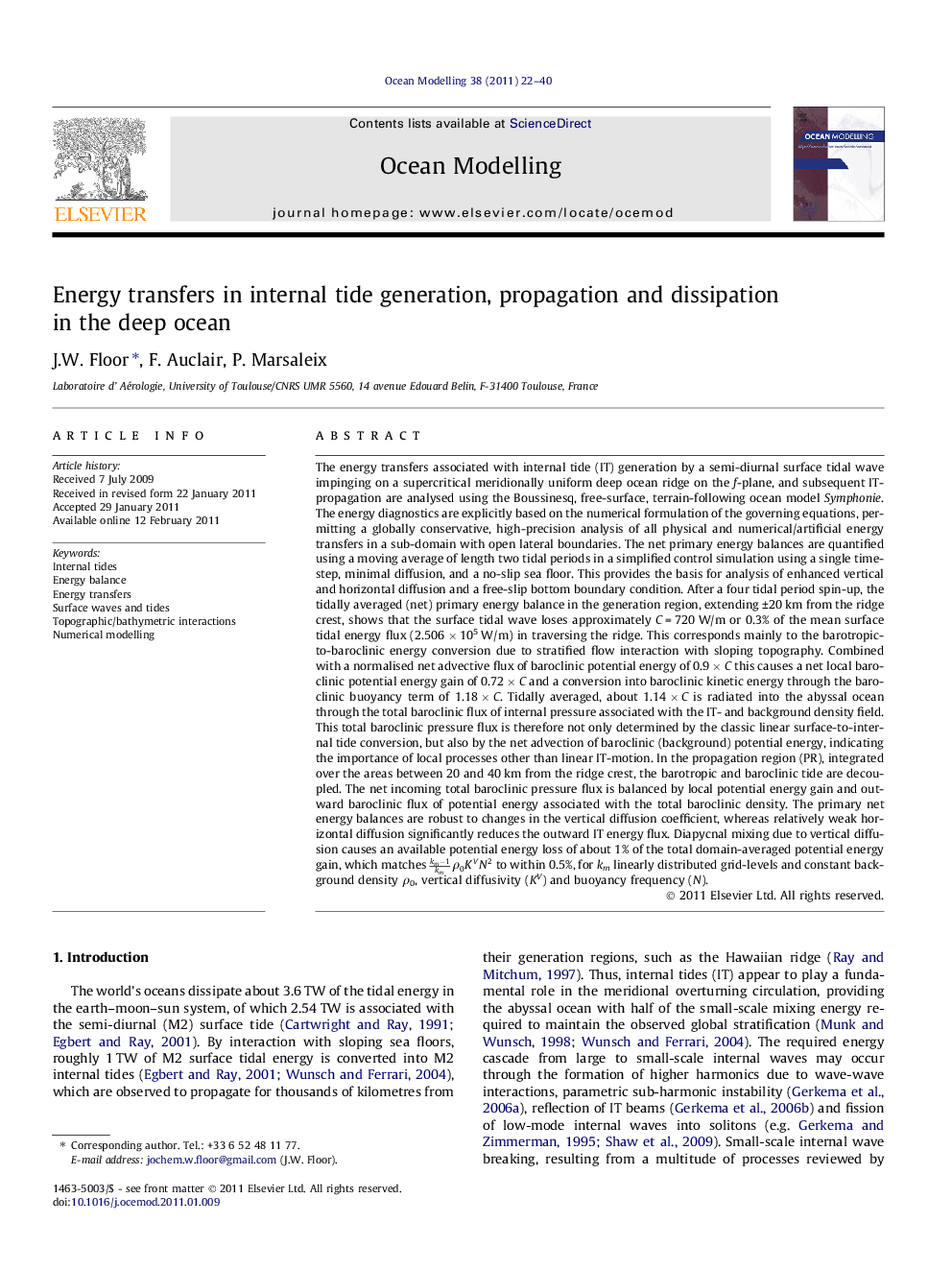| کد مقاله | کد نشریه | سال انتشار | مقاله انگلیسی | نسخه تمام متن |
|---|---|---|---|---|
| 4552282 | 1627805 | 2011 | 19 صفحه PDF | دانلود رایگان |

The energy transfers associated with internal tide (IT) generation by a semi-diurnal surface tidal wave impinging on a supercritical meridionally uniform deep ocean ridge on the f-plane, and subsequent IT-propagation are analysed using the Boussinesq, free-surface, terrain-following ocean model Symphonie. The energy diagnostics are explicitly based on the numerical formulation of the governing equations, permitting a globally conservative, high-precision analysis of all physical and numerical/artificial energy transfers in a sub-domain with open lateral boundaries. The net primary energy balances are quantified using a moving average of length two tidal periods in a simplified control simulation using a single time-step, minimal diffusion, and a no-slip sea floor. This provides the basis for analysis of enhanced vertical and horizontal diffusion and a free-slip bottom boundary condition. After a four tidal period spin-up, the tidally averaged (net) primary energy balance in the generation region, extending ±20 km from the ridge crest, shows that the surface tidal wave loses approximately C = 720 W/m or 0.3% of the mean surface tidal energy flux (2.506 × 105 W/m) in traversing the ridge. This corresponds mainly to the barotropic-to-baroclinic energy conversion due to stratified flow interaction with sloping topography. Combined with a normalised net advective flux of baroclinic potential energy of 0.9 × C this causes a net local baroclinic potential energy gain of 0.72 × C and a conversion into baroclinic kinetic energy through the baroclinic buoyancy term of 1.18 × C. Tidally averaged, about 1.14 × C is radiated into the abyssal ocean through the total baroclinic flux of internal pressure associated with the IT- and background density field. This total baroclinic pressure flux is therefore not only determined by the classic linear surface-to-internal tide conversion, but also by the net advection of baroclinic (background) potential energy, indicating the importance of local processes other than linear IT-motion. In the propagation region (PR), integrated over the areas between 20 and 40 km from the ridge crest, the barotropic and baroclinic tide are decoupled. The net incoming total baroclinic pressure flux is balanced by local potential energy gain and outward baroclinic flux of potential energy associated with the total baroclinic density. The primary net energy balances are robust to changes in the vertical diffusion coefficient, whereas relatively weak horizontal diffusion significantly reduces the outward IT energy flux. Diapycnal mixing due to vertical diffusion causes an available potential energy loss of about 1% of the total domain-averaged potential energy gain, which matches km-1kmρ0KVN2 to within 0.5%, for km linearly distributed grid-levels and constant background density ρ0, vertical diffusivity (KV) and buoyancy frequency (N).
Research highlights
► We model a closed energy balance of internal tide generation over a deep ocean ridge.
► The surface tide loses C = 720 W/m (0.3%) to buoyancy flux in traversing the ridge.
► Buoyancy flux and PE advection (0.9C) cause 0.72C baroclinic PE and 1.18 KE gain.
► The internal tide pressure flux is 1.14C into the abyssal ocean.
► Diapycnal mixing causes APE loss of 1% of the baroclinic PE gain.
Journal: Ocean Modelling - Volume 38, Issues 1–2, 2011, Pages 22–40